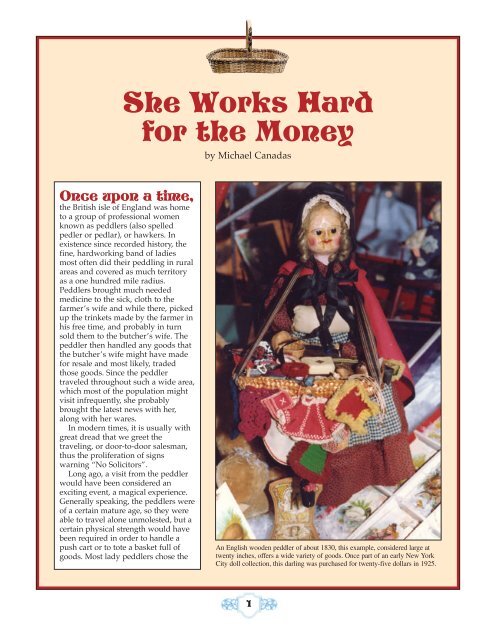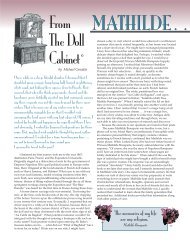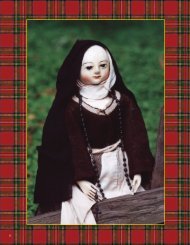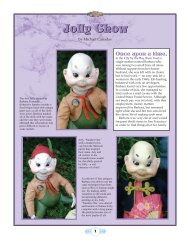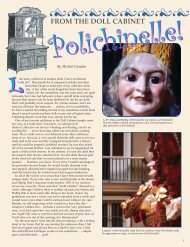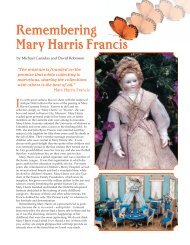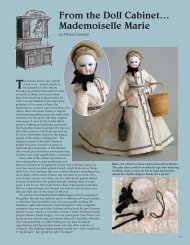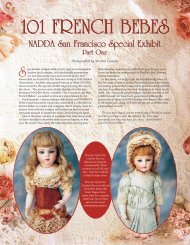She Works Hard for the Money - Carmel Doll Shop
She Works Hard for the Money - Carmel Doll Shop
She Works Hard for the Money - Carmel Doll Shop
- No tags were found...
You also want an ePaper? Increase the reach of your titles
YUMPU automatically turns print PDFs into web optimized ePapers that Google loves.
<strong>She</strong> <strong>Works</strong> <strong>Hard</strong><br />
<strong>for</strong> <strong>the</strong> <strong>Money</strong><br />
by Michael Canadas<br />
Once upon a time,<br />
<strong>the</strong> British isle of England was home<br />
to a group of professional women<br />
known as peddlers (also spelled<br />
pedler or pedlar), or hawkers. In<br />
existence since recorded history, <strong>the</strong><br />
fine, hardworking band of ladies<br />
most often did <strong>the</strong>ir peddling in rural<br />
areas and covered as much territory<br />
as a one hundred mile radius.<br />
Peddlers brought much needed<br />
medicine to <strong>the</strong> sick, cloth to <strong>the</strong><br />
farmer’s wife and while <strong>the</strong>re, picked<br />
up <strong>the</strong> trinkets made by <strong>the</strong> farmer in<br />
his free time, and probably in turn<br />
sold <strong>the</strong>m to <strong>the</strong> butcher’s wife. The<br />
peddler <strong>the</strong>n handled any goods that<br />
<strong>the</strong> butcher’s wife might have made<br />
<strong>for</strong> resale and most likely, traded<br />
those goods. Since <strong>the</strong> peddler<br />
traveled throughout such a wide area,<br />
which most of <strong>the</strong> population might<br />
visit infrequently, she probably<br />
brought <strong>the</strong> latest news with her,<br />
along with her wares.<br />
In modern times, it is usually with<br />
great dread that we greet <strong>the</strong><br />
traveling, or door-to-door salesman,<br />
thus <strong>the</strong> proliferation of signs<br />
warning “No Solicitors”.<br />
Long ago, a visit from <strong>the</strong> peddler<br />
would have been considered an<br />
exciting event, a magical experience.<br />
Generally speaking, <strong>the</strong> peddlers were<br />
of a certain mature age, so <strong>the</strong>y were<br />
able to travel alone unmolested, but a<br />
certain physical strength would have<br />
been required in order to handle a<br />
push cart or to tote a basket full of<br />
goods. Most lady peddlers chose <strong>the</strong><br />
An English wooden peddler of about 1830, this example, considered large at<br />
twenty inches, offers a wide variety of goods. Once part of an early New York<br />
City doll collection, this darling was purchased <strong>for</strong> twenty-five dollars in 1925.<br />
1
A large English<br />
wooden with<br />
piercing blue eyes<br />
that we associate<br />
with <strong>the</strong> George IV<br />
era, but retaining<br />
earlier features<br />
such as stippled<br />
eyebrows and early<br />
type lea<strong>the</strong>r arms.<br />
Dressed to<br />
represent a Welsh<br />
peddler with<br />
requisite, tall black<br />
hat and red cape,<br />
she specializes in<br />
sewing supplies –<br />
note her fine<br />
printed cotton<br />
yardage.<br />
A very fine German papier-mâché with an Apollo knot hairstyle<br />
hidden under her bonnet, she offers something <strong>for</strong> everyone.<br />
Especially unusual is her “fur” trimmed cape.<br />
latter method, as many of <strong>the</strong>m covered remote<br />
areas that might prove unfriendly to a wheeled cart.<br />
Classic sayings such as “you cannot sell from an<br />
empty cart” herald back to <strong>the</strong> street peddling<br />
profession. Some sort of peddler could be found in<br />
every country imaginable – from Russia to<br />
America, but it is indeed England that benefited<br />
from <strong>the</strong> notion of <strong>the</strong> peddler with newly arrived<br />
Jewish immigrants in <strong>the</strong> seventeenth-century.<br />
Through street peddling, those newcomers were<br />
able to get on <strong>the</strong>ir feet, and <strong>the</strong>n would later move<br />
into o<strong>the</strong>r professions as tailors, shoe makers,<br />
dressmakers and bankers.<br />
Throughout Europe, <strong>the</strong> peddling profession was<br />
strictly limited to men, but in England, women<br />
were welcomed, allowing equal opportunity.<br />
2
Some of <strong>the</strong> first commercially made peddler dolls – this pair of “White’s” features<br />
lea<strong>the</strong>r faces, with <strong>the</strong>ir happy features painted on. The well-dressed duo offers a<br />
wide assortment of fine goods such as graters, buttons, inkwells, decorative<br />
screens and hanks of cording. Circa 1820s, <strong>the</strong>ir condition is excellent.<br />
An enchanting<br />
peg wooden of<br />
<strong>the</strong> type that<br />
Princess Victoria<br />
often played<br />
with, this tiny<br />
example is a<br />
basket specialist<br />
– tiny baskets!<br />
Mostly<br />
decorative today,<br />
baskets were at<br />
one time a<br />
mainstay in <strong>the</strong><br />
kitchen and<br />
throughout<br />
<strong>the</strong> entire<br />
house.<br />
Formerly in <strong>the</strong><br />
John Darcy Noble<br />
collection, this<br />
early 1830s, alloriginal,<br />
wooden<br />
peddler boasts<br />
delicate facial<br />
features and a<br />
basket chock<br />
full of useful<br />
wares.<br />
3
“Jenny Moss Licensed Pedler” announces <strong>the</strong> paper license<br />
on display, which helps to establish her age, after 1842 due to<br />
<strong>the</strong> license law. Jenny Moss is a gem of a papier-mâché on a<br />
wooden articulated body and originated from a home on<br />
England’s Isle of Wight. There she resided under a glass<br />
dome, which was nearly always kept covered – thus her<br />
bright condition. <strong>She</strong> definitely enjoyed a successful career,<br />
just look at her basket overflowing with wonderful items!<br />
Made of an unknown material, possibly beeswax, this hag<br />
must have had to work very hard <strong>for</strong> her money! Her license<br />
was issued in 1851 leading us to believe that perhaps she was<br />
sold at <strong>the</strong> Crystal Palace Exhibition Regardless, her<br />
comical sculpting was certainly meant to induce a smile.<br />
4
Ultimately, England revered <strong>the</strong><br />
street peddler more than any o<strong>the</strong>r<br />
nation and today, that fact is<br />
evident in <strong>the</strong> three dimensional<br />
likenesses left to us in <strong>the</strong> <strong>for</strong>m of<br />
dolls. Honestly, what o<strong>the</strong>r<br />
profession has been so<br />
meticulously portrayed in<br />
miniature <strong>for</strong> us to study over a<br />
century later Peddler dolls are an<br />
enchanting way <strong>for</strong> us to take<br />
inventory of goods available <strong>for</strong><br />
sale at that time – <strong>the</strong>y could<br />
actually be described as intact,<br />
small shops.<br />
While <strong>the</strong> baskets of some<br />
peddler dolls visibly portray <strong>the</strong><br />
goods of a specialty seller, such as<br />
those that offer a plethora of woven<br />
baskets or stationery supplies <strong>for</strong><br />
example, most carried merchandise<br />
in a broad range. A varied selection<br />
seems to suggest one who covered<br />
a rural area, so as to service as<br />
many of <strong>the</strong>ir customers needs as<br />
possible, while a peddler that<br />
specialized, probably worked in a<br />
densely populated urban area.<br />
Janet Walker, an outstanding salesperson and<br />
a very literate wax peddler, specializes in<br />
small wares – according to her license.<br />
Books and sewing items are her <strong>for</strong>te.<br />
5
6<br />
A rare pair of wax peddlers in elegant<br />
attire, this couple, <strong>for</strong>merly in <strong>the</strong><br />
John Darcy Noble collection, is laden<br />
with spectacular goods that vary<br />
from cricket balls to hymn books.
German papiermâché<br />
peddler dolls<br />
on wooden bodies.<br />
He is quite unique<br />
<strong>for</strong> his applied beard<br />
and she <strong>for</strong> her<br />
unusual basket.<br />
Note <strong>the</strong> fully<br />
constructed dress<br />
she offers, most<br />
peddlers do not sell<br />
ready to wear!<br />
It should be no surprise that <strong>for</strong><br />
many peddlers, dolls were a featured<br />
item, especially during <strong>the</strong> early years<br />
of <strong>the</strong> reign of Queen Victoria, which<br />
began in 1837.<br />
Through classic doll examples, <strong>the</strong><br />
cultural importance of <strong>the</strong> peddler is<br />
recognized.<br />
Several factors led to <strong>the</strong> demise of<br />
<strong>the</strong> street peddler and <strong>the</strong> greatest was<br />
<strong>the</strong> Industrial Revolution itself. The<br />
arcade, specialty shops and eventually<br />
<strong>the</strong> advent of <strong>the</strong> postal service, which<br />
allowed <strong>the</strong> offering and purchasing of<br />
items through <strong>the</strong> mail, all contributed<br />
to <strong>the</strong> end. Fur<strong>the</strong>r, <strong>the</strong> rail system also<br />
allowed <strong>the</strong> farmer and handcrafter to<br />
move <strong>the</strong>ir goods and services with<br />
great ease, also affecting <strong>the</strong> livelihoods<br />
of <strong>the</strong> hardworking, humble peddler.<br />
7
This couple has always<br />
been toge<strong>the</strong>r even though<br />
she is wood and he is<br />
made of a heavy type of<br />
papier mache.<br />
Each measures<br />
approximately eight<br />
inches. <strong>She</strong> carries<br />
predominately sewing<br />
notions and he is a seller<br />
of gloves, lea<strong>the</strong>r smalls<br />
and books.<br />
Kaonis Collection<br />
It was Victoria’s husband Prince Albert who<br />
noticed not only <strong>the</strong> subtle changes in <strong>the</strong><br />
English culture wrought by <strong>the</strong> evolution, but<br />
<strong>the</strong> plight of <strong>the</strong> English peddler. In 1842, he<br />
helped to enact a law pertaining to <strong>the</strong><br />
professional street seller. After that date, each<br />
peddler was required to display a license.<br />
Fur<strong>the</strong>rmore, in order to obtain <strong>the</strong> license, <strong>the</strong><br />
prospective merchant would need two people to<br />
vouch <strong>for</strong> <strong>the</strong>ir honest business practices and<br />
general integrity.<br />
Alas, <strong>the</strong> Victorian age progressed and with<br />
that, <strong>the</strong> humble street peddler would<br />
eventually become a quaint reminder of simpler<br />
times. That downfall of <strong>the</strong> flesh and blood<br />
peddler resulted in sentimental, miniature<br />
versions in wax, wood or papier-mâché residing<br />
under glass domes, which made appearances in<br />
drawing rooms throughout Victorian England.<br />
Those handmade versions might have been<br />
created by <strong>the</strong> lady of <strong>the</strong> house, or purchased<br />
from <strong>the</strong> very shops that helped put <strong>the</strong> peddler<br />
out of business.<br />
8
A very unusual peddler – unique <strong>for</strong> her youthful beauty, is<br />
attributed to wax modeler Henrietta Wade and dates circa 1860.<br />
Note her beautifully <strong>for</strong>med hands and bosom, while her<br />
exquisite inset silk hair is beautifully styled.<br />
9
10<br />
In my experience, peddler<br />
doll examples have always<br />
been popular with collectors,<br />
even those that do not<br />
necessarily harbor a taste <strong>for</strong><br />
early dolls. Un<strong>for</strong>tunately, in<br />
<strong>the</strong> past, some peddler dolls<br />
have fallen victim to dollhouse<br />
collectors who stripped <strong>the</strong><br />
dolls of <strong>the</strong>ir wares in order to<br />
decorate <strong>the</strong> miniature rooms.<br />
Thankfully, with peddler dolls<br />
now well represented in<br />
museums throughout <strong>the</strong><br />
world, finally receiving <strong>the</strong><br />
respect <strong>the</strong>y deserve, that<br />
practice is behind us.<br />
After all, peddlers are not<br />
just dolls – <strong>the</strong>y embody a longago<br />
time, never to be seen again<br />
– <strong>the</strong>y represent ladies that<br />
worked hard <strong>for</strong> <strong>the</strong> money –<br />
let’s treat <strong>the</strong>m right.


